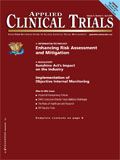Sunshine Act's Impact
Applied Clinical Trials
The amendment addresses data concerns for both physicians and drug/device manufacturers.
What is The Sunshine Act? What does it do? And, what impact will it have on physicians and drug and device manufacturers?
The Physician Payment Sunshine Act of 2007 is an amendment to Title XI of the Social Security Act. The purpose of the amendment is to make public financial dealings between doctors and their suppliers of medical products in an effort to keep those relationships true. It aims to ferret out unethical actions by requiring disclosure from everyone involved in healthcare transactions. Payments and transfers of value to physicians are normal parts of business and the majority is completely ethical and proper. The idea is that the more transparent the process, the more public scrutiny will steer all parties to better practices and will be a guard against questionable behavior.

RYAN MCVAY/GETTY IMAGES
The vast majority of physicians and manufacturers are honest, ethical, and above board in their dealings. But just the possibility of misbehavior makes additional disclosure initiatives like the Sunshine Act necessary. Physicians who supplement their income through gifts, grants, speaking fees, honoraria, etc. require oversight. If manufacturers offer financial favors to doctors to support their product more than the competition's product, they need to be policed.
There have always been laws against the quid-pro-quo type of transfer of value (i.e., paying the doctor through honoraria for prescribing your product more than competitors' products). Such activities are disreputable, and most professionals would never be party to such a blatant violation of law and professional ethics. The Sunshine Act will deter the unethical few from profiting from the manufacturers. It also will reduce wasteful spending in the industry and perhaps pass the savings to the public consumer in the best interests of patients. The new law concentrates on making all relationships more visible instead of trying to weed out what is undue influence or investigating suspect transactions. This self-policing model works well in an industry like healthcare where the vast majority is highly ethical and interested in doing the right thing.

What must be reported?
The basics: Each quarter, all drug and medical device manufacturers with more than $100 million in annual gross revenues have to report all transfers of value greater than $25 directly to a physician or to any third party where the physician will derive financial gain. The companies are required to reveal the same basic principles that every journalist learns to report—the who, what, when, where, how, and why.
- Who. Name of the physician, or the third party to whom the payment was made that can benefit the physician. Also required is the facility with which the physician is affiliated (i.e., the company has to report the hospital where the physician works). The act aims to identify the possibility of aggregated derived benefit from multiple physicians affiliated with the same organization indirectly influencing the organization.
- What. A description of the nature of the transfer. This includes compensation, food, entertainment, gifts, trips, travel, a product or other items provided for less than market value, participation in a medical conference, continuing education program, product rebates, discounts, consulting fees, honoraria, and any other economic benefit as defined by the Department of Health and Human Services.
- When. The date of the transfer of value.
- Where. The address of the receiver.
- How Much. The value of the transfer.
- Why. The medical issue or condition addressed, if any, that was the basis for the payment of transfer.
What if you don't report these transactions?
Non-compliance with the disclosure requirements of the act will incur fines of between $10,000 and $100,000 per infraction. How it will be enforced (i.e., what constitutes a $10,000 vs. $100,000 infraction) is still unclear. The transfer of value, which can be as little as $25, will have enormous impact on the cost of doing business if not reported.
The act goes far beyond the pedestrian straightforward, cash payment. It includes a number of gray items. Meals, entertainment, tuition for continuing-education classes, trips, seminars, and many other transactions are covered under the act.
The primary questions about any transfer of value are three-fold: first, the intent; second, the effect; and finally, the perception.
What is the intent of the transfer of value? Companies can provide a fair value for the time and effort the physician extends, on behalf of the company, for speaking engagements. Companies can also fund product marketing, product information, and product samples so doctors can provide proper treatment and information to patients. However, it is a major concern if the effort influences the physician to act in his own financial interest and not in the best interest of the patient.
What is the effect of the transfer? Does the physician retain his or her objectivity, or does the transfer of value color his clinical decision-making? This is the most important aspect and the hardest to measure. Everything we do has some influence on our decision-making. Our perceptions are influenced many times every day—often only in subtle ways—but influenced nonetheless.
What is the perception? Does the payment or transfer of value generate an appearance of impropriety? The fact is there is no provision in the amendment banning any form of financial transfer per se. This seems to indicate that the authors are using a reasonable approach of allowing transparency to weed out the undue influence from normal business transactions.
Most people would argue that having a preeminent physician in their field speak at an industry-sponsored seminar on the benefits of a new medicinal product is valuable to all the attending physicians, as it gives a clinician's perspective on the topic. Further, most would agree that compensating the doctor for his time at the conference is reasonable. The Sunshine Act forces the question: What is proper? The act requires the reporting of all transactions, and the subsequent release of that information to the public. "Shedding light" on the subject is the derivation of the word "Sunshine" in the act's title.
If a particular deal does not survive review by the public, then it possibly should never have been made—that is the primary premise of the act. What is undue influence is a grey area. As I touched on earlier, the effect of the transfer is very hard to read and evaluate. With the information naked to the light of day and public scrutiny, the idea is that the interested parties will police themselves.
Most professionals work very hard at assuring there is no impropriety. An unfortunate effect of this act, however, may cause well-meaning professionals to avoid legitimate educational opportunities for fear of a political backlash. Also, the increased record keeping and management of disclosure information will increase the cost of business. These costs will be passed on to the consumer. There is also the possibility that disclosure of legitimate transfers of value will be taken out of context and will cause actual damage to the companies due to negative public opinion. Time will tell, as the public disclosure is in full force in 2014.
Another aspect of transparency, which may have a greater short-term effect on physicians, is the self-referral disclosure.
For imaging services, for example, the referring physician must inform the individual at the time of the referral that:
- The individual may obtain the services from a party other than: the referring physician, a physician who is a member of the same group practice as the referring physician, or an individual who is directly supervised by the physician or by another physician in the group practice.
- The individual must be provided with a written list of suppliers who furnish services in the area in which the individual resides.
The practical effect of this will be a longer decision-making process on which imaging clinic patients will go and some unnecessary tests may be avoided. However, the number of extra tests is unlikely to decrease by any significant amount.
The primary problem is the foundation of the fee-for-services model of healthcare. We can talk about healthcare reform, cost containment, managed care, etc. However, our system is designed to increase overall healthcare spending, regardless of the efficacy of the care. The insurance reimbursement model is based on what the provider does to the patient, not how effective the procedure is.
Each modality, test, treatment, pill, and procedure has a billing code; the more that is done, the more the facility, doctor, or clinic can bill. Currently, there are conflicting motivations in healthcare.
Payers. Insurance companies' primary objectives are to generate revenue by writing policies and to manage the costs they pay out in settlements. Actuaries work diligently to ensure that an insurance company will maintain profitability in all reasonable scenarios.
Providers. These companies have their paperwork overhead increased, their reimbursement rates decreased, and their malpractice insurance rates increased. Their inclination is to prescribe more tests for two reasons: more services generate more fees and more services protect providers against lawsuits.
Product producers. They are the only party that has a straightforward part in this equation. Their goal is to provide improved healthcare and sell as much of their product as possible, while providing patent protection and fighting competition. Giving out gifts to prescribers is one of the most inexpensive forms of marketing they can implement. As there is such competition for the doctor's ear, vendors actively utilize this method of marketing. The Sunshine Act will look closely at this practice.
Patients. They want as much healthcare as possible and want to pay as little as possible. Many people take active steps to stay healthy, but others do not. We as a people would not need as much healthcare if we were healthier.
Litigators. Malpractice and product liability law is a major concern and cost. Without tort reform, healthcare reform in the world will not materially decrease the cost of medicine.
Regulators. They have to balance the safety of the public based on research data against the ongoing suffering of patients without new and novel products and services. Further, even when the regulators are correct 99 percent of the time, they are remembered for the 1 percent when they are incorrect. There are hundreds of products reviewed, approved, and providing value to the public. It is the few products with issues that require these measures. It is a difficult position to be in, where the user fees and fines you levy from the industry you regulate is from the source of the vast majority of your revenue.
Cutting the cost of healthcare
Our underlying system reinforces this less than optimal payment/services/control cycle. Something will have to change before we make a real dent in the cost of healthcare.
There is a shift coming from a fee-for-services model to a health-outcomes-based model where the healthcare providers are paid based on the outcome for the patient. There are already examples of this transition. In many areas, obstetrics services are charged on a flat-fee-per-birth basis. If we move from a fee-for-services model to a fee-for-outcome model, the financial incentive to perform more tests will decrease. Of course, this also requires tort reform being simultaneously implemented.
What we do with the information provided to the public by this disclosure law will affect healthcare. If we overreact or take the information out of context, the effect will be to decrease the quality of care, through the decrease in educational and knowledge sharing opportunities of doctors. The healthcare industry as a whole, from providers to payers to product providers to lawyers, must approach this new scenario as a new opportunity to improve their performance and profitability. By focusing on the positive aspects and modifying their business processes to take advantage of this new worldview, they can improve their image in the eyes of the public and, more importantly, in the eyes of the patient. Those who rail against this new law will be left in the dust by those who embrace it and use it to improve their market share.
Providers who focus on relevant tests will reduce stress and cost to their patients, reduce their own paperwork and re-work, and improve their relations with the payers. A holistic approach to this situation will allow the greatest market and financial successes. The provider that engages in practices that lower the number of payer appeals saves money. The payer that has developed a history with a provider can streamline its documentation review processes. The product producer that recognizes that the public's opinion of the organization is its single most critical asset in the market will focus on that aspect and soon have patients requesting its products when they have a choice in therapies. Marketing the product producing company itself and gaining patient trust and approval will likely be more effective than marketing the drugs to the providers.
Conclusion
By focusing the marketing and sales efforts on better patient care, rather than on costs and profits, all parties in healthcare fields will prosper. An example can easily be seen in the "health-wise" programs of many payers, where instilling "healthy" objectives in their customers (patients) pays off in lower overall costs and greater customer faith and loyalty. Sticking our heads in the sand and wishing for the success of the Sunshine Act away will do nothing but frustrate senior managers and reduce profitability. Focusing on how to best embrace this new scenario and how to increase market share using this new set of rules will be critical to financial success—and perhaps even survival— over the next decade.
Roy Devine is Associate Vice President Healthcare at iGATE Patni, 6528 Kaiser Drive, Fremont, CA, e-mail: Roy.Devine@igatepatni.com

FDA to Launch National Priority Voucher Program to Speed Drug Reviews for Critical Therapies
June 18th 2025Under the new initiative, companies may receive a voucher enabling FDA review to be shortened from the standard 10–12 months to just 1–2 months following final application submission if the drug addresses US national health priorities.
FDA Outlines Updated Requirement for Placebo-Controlled Trials in Vaccine Research
May 21st 2025In an article recently published by The New England Journal of Medicine, FDA higher-ups Vinay Prasad, MD, MPH; and Martin A. Makary, MD, MPH, wrote that any new COVID-19 vaccine must now be evaluated in placebo-controlled studies.
Phase III SELECT-GCA Trial Results Lead to FDA Approval of Rinvoq for Giant Cell Arteritis
April 30th 2025Rinvoq (upadacitinib) becomes the first oral JAK inhibitor approved by the FDA for the treatment of giant cell arteritis in adults, following robust data from the Phase III SELECT-GCA trial demonstrating its efficacy in achieving sustained remission and reducing glucocorticoid exposure.